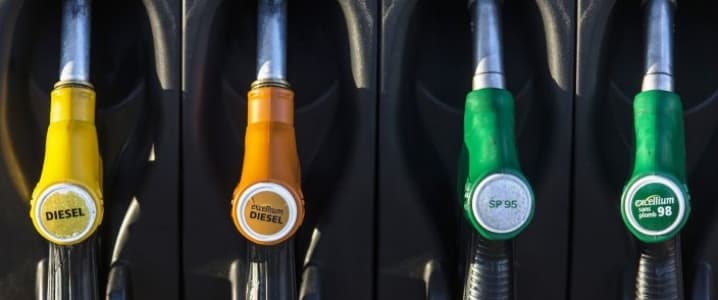The oil products that we use—such as gasoline, diesel, and heating oil—are all refined from crude oil. If the demand for these refined products increases, then the demand for crude oil as a raw material will also go up. So why are we not seeing this correlation?
As a trader, it is important to note two things while analyzing crude oil prices. One is to monitor the crude oil supply in the market. The second is to track the trend in consumption of crude oil’s finished products.
Let’s first have a look at both gasoline and distillates, and then move on to crude oil supplies.
(Click to enlarge)
The chart above shows that while the crude oil stockpiles were rising to new record highs in February and March, gasoline inventory was falling. Is this a noteworthy event?
In order to understand the significance of the fall, let’s see the history of the past few years. We note that since 2011 onward, this has been a cyclical occurrence. The gasoline inventory level peaks like clockwork around the second week of February, after which the drawdown begins. This time is no different.
Though the drop in gasoline inventory is important, it doesn’t show a new wave of gasoline demand, which can be a case for bullish crude oil prices.
Related: OPEC Deal Extension Looks Shaky As Shale Hedges Production
But what about distillates?
The inventory data of distillates shows a larger than usual drop of around 10 percent, from a high of 170.7 million barrels in the week ending February 03 to 152.9 million barrels in the week ending March 24, 2017. This is one of the largest drops in distillate inventory since 2013, when there was a similar drop from 129.5 million barrels to 115.2 million barrels during similar weeks. In between 2013-2017, the inventory levels had remained more or less stagnant during the period between February and March.
The gasoline inventory has fallen for the past six consecutive weeks, whereas the distillate inventory levels have dropped for seven consecutive weeks. This, however, is not a great deviation from the record of the past five years. Nevertheless, if the drawdown in both gasoline and distillates continue in the coming weeks, it will become noteworthy.
The most important number to note still continues to be the OPEC production data and the increase in the U.S. oil production. Without OPEC’s production cuts, the market would still be in a surplus. However, if crude oil prices fail to rise, it will be interesting to note OPEC’s reaction in their next meeting.
On the other hand, if the U.S. crude oil production, along with Libya, which is exempt from production cuts, keeps rising at a fast pace to replace the OPEC barrels, it will be a negative for the oil market. Related: World’s Biggest LNG Exporter Just Raised The Stakes
"The rebound of Libyan production stalled the rally," Gene McGillian, manager of market research for Tradition Energy in Stamford, Connecticut, said by telephone. "We were rallying on the signs that the OPEC production agreement will be extended," reports World Oil.
However, a few experts believe that the market is fixated on U.S. oil inventories, instead of seeing the overall picture of the globe. A Morgan Stanley report said that OPEC production cuts have started to have their desired effect. The crude stockpiles in China, Japan, and floating storage around the world have declined 72 million barrels this year, reports Bloomberg. It is only a matter of time before U.S. inventories follow suit.
"We believe the implemented production cuts will trigger a material drawdown in OECD oil inventories and thus higher crude oil prices," UBS analyst Giovanni Staunovo said, referring to the Organization for Economic Co-operation and Development. "We expect Brent oil prices to rise above $60 a barrel in three months," reports Reuters.
By Rakesh Upadhyay for Oilprice.com
More Top Reads From Oilprice.com:
- Oil Prices Plunge After Crude Inventories Rise To New Highs
- Tanker Traffic Points At Much Tighter Oil Markets
- Are Mexico’s Oil Reserves Almost Depleted?




















Unprofessional and deceptive.